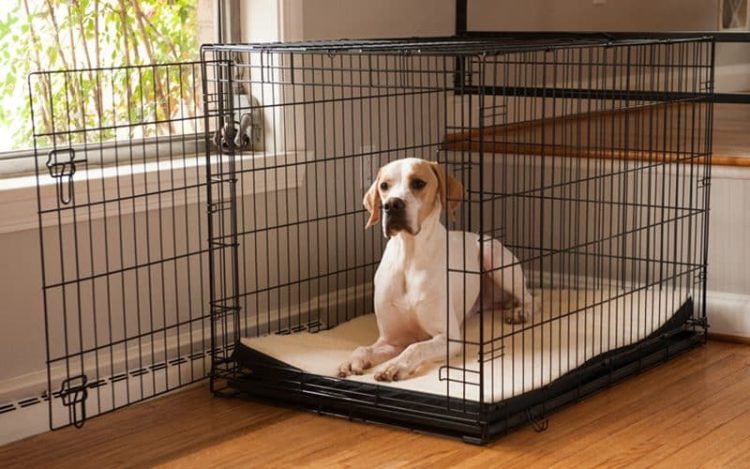Crate training is one of the most effective ways to create a safe, comfortable space for your pet while also improving behavior and reinforcing good habits. Whether you have a dog or a cat, a crate can serve as a sanctuary for your pet, as well as a useful tool for house training, traveling, and preventing destructive behavior. The key to successful crate training lies in using the crate as a positive, secure space for your pet, not as a form of punishment.
In this guide, we’ll walk you through the process of crate training your pet, explore the benefits of this method, and address common challenges that may arise along the way.
Why Crate Train Your Pet?
Before delving into the specifics of crate training, it’s important to understand why crate training is beneficial for both you and your pet. Crates can offer many advantages, such as:
1. Safety and Security
A crate provides a secure environment for your pet when you cannot supervise them. This is especially important when traveling in a car, flying, or leaving them home alone. It prevents your pet from getting into potentially dangerous situations, such as chewing on electrical cords or swallowing harmful items.
2. Aid in House Training
Crates are invaluable for housebreaking puppies and kittens. Animals are naturally inclined to avoid soiling their sleeping areas. By using a crate, you can help your pet develop a consistent bathroom routine. When the crate is the right size, it encourages your pet to hold their bladder until they are let outside.
3. A Safe Haven for Relaxation
Pets need their own space, and a crate can become a designated area where they can retreat when they need quiet time. This is particularly useful for dogs who may feel overwhelmed by loud noises or large crowds, or for cats who enjoy having a safe, enclosed spot to sleep.
4. Prevents Destructive Behavior
Crates can also be used to prevent pets from chewing on furniture, scratching walls, or engaging in other destructive behaviors when left unsupervised.
5. Traveling Made Easier
A crate-trained pet is more comfortable and secure while traveling, whether by car or air. This can help reduce anxiety during long trips and ensure your pet’s safety during transportation.
The Right Crate for Your Pet
Before starting crate training, it’s important to select the right crate for your pet. Choosing the appropriate crate will ensure your pet’s comfort and safety during training and beyond.
1. Size of the Crate
The crate should be large enough for your pet to stand up, turn around, and lie down comfortably. For dogs, a crate that is too large can defeat the purpose of house training, as they may use one side of the crate as a bathroom and the other side for sleeping. For puppies, ensure the crate is adjustable so you can make it smaller as they grow, which helps prevent them from eliminating in the crate.
2. Material of the Crate
Crates come in different materials, including wire, plastic, and fabric. Wire crates are often the best option for dogs because they offer good ventilation and visibility. Plastic crates are typically used for traveling and are more enclosed, which may be preferable for pets who feel anxious in open spaces. Fabric crates are lightweight and portable but may not be as durable or secure.
3. Safety Features
Ensure the crate has safe latches and that there are no sharp edges or small gaps that could be hazardous to your pet. If using a travel crate, ensure that it is airline-approved if you plan to fly with your pet.
Step-by-Step Guide to Crate Training
Now that you have the right crate for your pet, it’s time to start the training process. Crate training takes patience, consistency, and positive reinforcement. Here’s a step-by-step guide to help you train your pet to love their crate.
Step 1: Introduce Your Pet to the Crate
The first step in crate training is to introduce your pet to the crate in a calm and positive manner. Start by placing the crate in a quiet area of your home, such as a living room or hallway, where your pet feels comfortable.
- Leave the Door Open: Allow your pet to explore the crate on their own by leaving the door open. Don’t force them inside. Place some treats, toys, or a comfortable blanket inside the crate to make it more inviting.
- Positive Association: Spend time near the crate, praising and rewarding your pet when they show interest in it. Let them investigate the crate at their own pace. Never use the crate as a form of punishment, as this will create negative associations.
Step 2: Encourage Your Pet to Enter the Crate
Once your pet is comfortable exploring the crate, begin encouraging them to enter it voluntarily.
- Use Treats or Toys: Place treats, toys, or their favorite blanket inside the crate to entice them to enter. Don’t push them inside; let them go in on their own.
- Short Sessions: Start by keeping the door open while your pet is inside, and give them treats or praise for staying inside for a few moments. Gradually increase the time they spend inside the crate as they become more comfortable.
- Feed Meals in the Crate: To build a positive association with the crate, start feeding your pet their meals inside the crate. Place their food dish near the back of the crate, so they need to enter to eat.

Step 3: Close the Door for Short Periods
Once your pet is comfortable entering the crate, begin closing the door for short periods while they are inside.
- Gradually Increase Time: Start by closing the door for just a few seconds and then open it. Gradually increase the time they spend in the crate with the door closed.
- Stay Calm and Patient: If your pet starts to cry or whine, don’t immediately open the door. Wait until they are calm before letting them out. This teaches them that quiet behavior is rewarded.
Step 4: Crate Your Pet When You’re Away
Once your pet is comfortable spending short periods in the crate, start leaving them in the crate when you leave the house. Begin with short departures, such as stepping out for a few minutes, and gradually increase the time away.
- Consistency Is Key: Keep your departure and return low-key to avoid creating anxiety. If you make a big deal out of leaving or coming home, it can increase your pet’s anxiety.
- Provide Comfort Items: Leave a blanket, toy, or chew item in the crate to help keep your pet calm while you’re gone.
Step 5: Increase Crate Time for Long Trips
As your pet becomes more comfortable with crate training, you can gradually extend the time they spend in the crate, such as during car rides or longer stays at home.
- Travel Crates: If you plan to travel, ensure your pet is accustomed to spending time in their crate before embarking on long trips. Whether traveling by car, train, or plane, a pet that is used to their crate will feel more secure.
Common Challenges in Crate Training
While crate training is an effective method for many pets, it can present challenges. It’s important to be patient and consistent. Here are some common obstacles and how to address them:
1. Separation Anxiety
Pets may experience anxiety when left in the crate, especially if they are used to constant companionship. To ease anxiety:
- Gradually increase the time your pet spends in the crate.
- Offer comfort items, such as a favorite blanket or chew toy.
- Leave the radio or TV on to provide soothing background noise.
- Avoid making the crate a “punishment” area, as this can exacerbate anxiety.
2. Whining and Crying
It’s natural for some pets to whine or cry when first placed in the crate. If this happens:
- Don’t give in to the whining by letting them out immediately.
- Wait for a moment of calm before opening the door.
- Consistency is key—remain patient and allow your pet to adjust at their own pace.
3. Reluctance to Enter the Crate
Some pets may resist entering the crate. To overcome this:
- Gradually introduce the crate with positive associations like treats and toys.
- Avoid using force to push your pet inside. Let them explore the crate at their own pace.
- Place the crate in a familiar, low-stress area to help them feel more comfortable.
4. Inconsistent Training
Inconsistent training can confuse your pet and delay progress. Ensure that everyone in the household is on the same page regarding crate training practices, including the use of rewards and the timing of training sessions.
Conclusion
Crate training can be a highly effective way to provide your pet with a secure, safe space, and help with various behavioral and house-training issues. While it requires patience, consistency, and positive reinforcement, the benefits of crate training are well worth the effort. Your pet will learn to view the crate as a place of comfort, relaxation, and safety, which can improve their overall well-being.
By following the steps outlined in this guide, you can successfully crate train your pet and address common challenges along the way. Remember to always use positive reinforcement, keep sessions short and enjoyable, and avoid using the crate as a punishment. With time and consistency, your pet will develop a positive relationship with their crate and feel comfortable spending time in it.























































